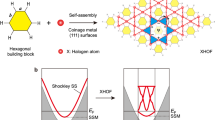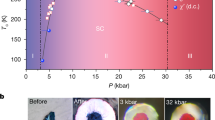Abstract
The application of pressure to solid iodine forces the molecules in the crystal to approach each other until intermolecular distances become comparable to the bond length of iodine; at this point, the molecules lose their identity and are essentially dissociated. According to room-temperature X-ray diffraction studies1, this process involves direct dissociation of iodine molecules at about 21 GPa, whereas spectroscopic observations2,3 have identified intermediate molecular phases at pressures ranging from 15 to 30 GPa. Here we present quasi-hydrostatic powder X-ray diffraction measurements that clearly reveal an intermediate phase during the pressure-induced dissociation of solid iodine. We find that, similar to the behaviour seen in uranium4, the structure of this intermediate phase is incommensurately modulated, with the nearest interatomic distances continuously distributed over the range 2.86–3.11 Å. The shortest of these interatomic distances falls between the bond length of iodine in the molecular crystal (2.75 Å) and the nearest interatomic distance in the fully dissociated monatomic crystal (2.89 Å), implying that the intermediate phase is a transient state during molecular dissociation. We expect that further measurements at different temperatures will help to elucidate the origin and stability of the incommensurate structure, which might lead to a better understanding of the molecular-level mechanism of the pressure-induced dissociation seen here and in the molecular crystals of hydrogen5, oxygen6 and nitrogen7.
This is a preview of subscription content, access via your institution
Access options
Subscribe to this journal
Receive 51 print issues and online access
$199.00 per year
only $3.90 per issue
Buy this article
- Purchase on Springer Link
- Instant access to full article PDF
Prices may be subject to local taxes which are calculated during checkout




Similar content being viewed by others
References
Takemura, K., Minomura, S., Shimomura, O. & Fujii, Y. Observation of molecular dissociation of iodine at high pressure by x-ray diffraction. Phys. Rev. Lett. 45, 1881–1884 (1980)
Pasternak, M., Farrell, J. N. & Taylor, R. D. Metallization and structural transformation of iodine under pressure: A microscopic view. Phys. Rev. Lett. 58, 575–578 (1987)
Olijnyk, H., Li, W. & Wokaun, A. High-pressure studies of solid iodine by Raman spectroscopy. Phys. Rev. B 50, 712–716 (1994)
van Smaalen, S. & George, T. F. Determination of the incommensurately modulated structure of α-uranium below 37 K. Phys. Rev. B 35, 7939–7951 (1987)
Mao, H.-K. & Hemley, R. J. Ultrahigh-pressure transitions in solid hydrogen. Rev. Mod. Phys. 66, 671–692 (1994)
Weck, G., Loubeyre, P. & LeToullec, R. Observation of structural transformations in metal oxygen. Phys. Rev. Lett. 88, 035504 (2002)
Eremets, M. I., Hemley, R. J., Mao, H.-K. & Gregoryanz, E. Semiconducting non-molecular nitrogen up to 240 GPa and its low-pressure stability. Nature 411, 170–174 (2001)
Shimomura, O. et al. Structure analysis of high-pressure metallic state of iodine. Phys. Rev. B 18, 715–719 (1978)
Takemura, K., Minomura, S., Shimomura, O., Fujii, Y. & Axe, J. D. Structural aspects of solid iodine associated with metallization and molecular dissociation under high pressure. Phys. Rev. B 26, 998–1004 (1982)
Riggleman, B. M. & Drickamer, H. G. Approach to the metallic state as obtained from optical and electrical measurements. J. Chem. Phys. 38, 2721–2724 (1963)
Sakai, N., Takemura, K. & Tsuji, K. Electrical properties of high-pressure metallic modification of iodine. J. Phys. Soc. Jpn 51, 1811–1816 (1982)
Fujii, Y., Hase, K., Ohishi, Y., Hamaya, N. & Onodera, A. Pressure-induced monatomic tetragonal phase of metallic iodine. Solid State Commun. 59, 85–89 (1986)
Fujii, Y. et al. Pressure-induced face-centered-cubic phase of monatomic metallic iodine. Phys. Rev. Lett. 58, 796–799 (1987)
Reichlin, R. et al. Optical, x-ray, and band-structure studies of iodine at pressures of several megabars. Phys. Rev. B 49, 3725–3733 (1994)
Takemura, K. Evaluation of the hydrostaticity of a helium-pressure medium with powder x-ray diffraction techniques. J. Appl. Phys. 89, 662–668 (2001)
Yamamoto, A. et al. Rietveld analysis of the modulated structure in the superconducting oxide Bi2(Sr,Ca)3Cu2O8+x. Phys. Rev. B 42, 4228–4239 (1990)
Wilson, A. J. C. & Prince, E. (eds) International Tables for Crystallography Vol. C, 2nd edn, 914–926 (Kluwer Academic, Dordrecht, 1999)
Luty, T. & Raich, J. C. Molecular to atomic transformation in solid iodine under high pressure. Can. J. Chem. 66, 812–818 (1988)
Nelmes, R. J., Allan, D. R., McMahon, M. I. & Belmonte, S. A. Self-hosting incommensurate structure of barium IV. Phys. Rev. Lett. 83, 4081–4084 (1999)
Fujihisa, H., Fujii, Y., Takemura, K. & Shimomura, O. Structural aspects of dense solid halogens under high pressure studied by x-ray diffraction—molecular dissociation and metallization. J. Phys. Chem. Solids 56, 1439–1444 (1995)
Fujii, Y. et al. Evidence for molecular dissociation in bromine near 80 GPa. Phys. Rev. Lett. 63, 536–539 (1989)
Takemura, K., Sahu, P. Ch, Kunii, Y. & Toma, Y. Versatile gas-loading system for diamond-anvil cells. Rev. Sci. Instrum. 72, 3873–3876 (2001)
Zha, C.-S., Mao, H.-K. & Hemley, R. J. Elasticity of MgO and a primary pressure scale to 55 GPa. Proc. Natl Acad. Sci. USA 97, 13494–13499 (2000)
Shimomura, O. et al. Application of an imaging plate to high-pressure X-ray study with a diamond anvil cell. Rev. Sci. Instrum. 63, 967–973 (1992)
Takemura, K. & Nakano, S. Performance of a synthetic diamond-backing plate for the diamond-anvil cell at ultrahigh pressures. Rev. Sci. Instrum. 74, 3017–3020 (2003)
Acknowledgements
We thank A. Yamamoto for the use of his programs for the analysis of the modulated structure, and O. Mishima for comments. The synchrotron radiation experiments were performed with the approval of the Photon Factory.
Author information
Authors and Affiliations
Corresponding author
Ethics declarations
Competing interests
The authors declare that they have no competing financial interests.
Rights and permissions
About this article
Cite this article
Kenichi, T., Kyoko, S., Hiroshi, F. et al. Modulated structure of solid iodine during its molecular dissociation under high pressure. Nature 423, 971–974 (2003). https://doi.org/10.1038/nature01724
Received:
Accepted:
Issue Date:
DOI: https://doi.org/10.1038/nature01724
This article is cited by
-
Formation of twelve-fold iodine coordination at high pressure
Nature Communications (2022)
-
Band gap closure, incommensurability and molecular dissociation of dense chlorine
Nature Communications (2019)
-
Anomalous bond length behavior and a new solid phase of bromine under pressure
Scientific Reports (2016)
-
Two- and three-dimensional extended solids and metallization of compressed XeF2
Nature Chemistry (2010)
-
Novel chain structures in group VI elements
Nature Materials (2005)
Comments
By submitting a comment you agree to abide by our Terms and Community Guidelines. If you find something abusive or that does not comply with our terms or guidelines please flag it as inappropriate.



